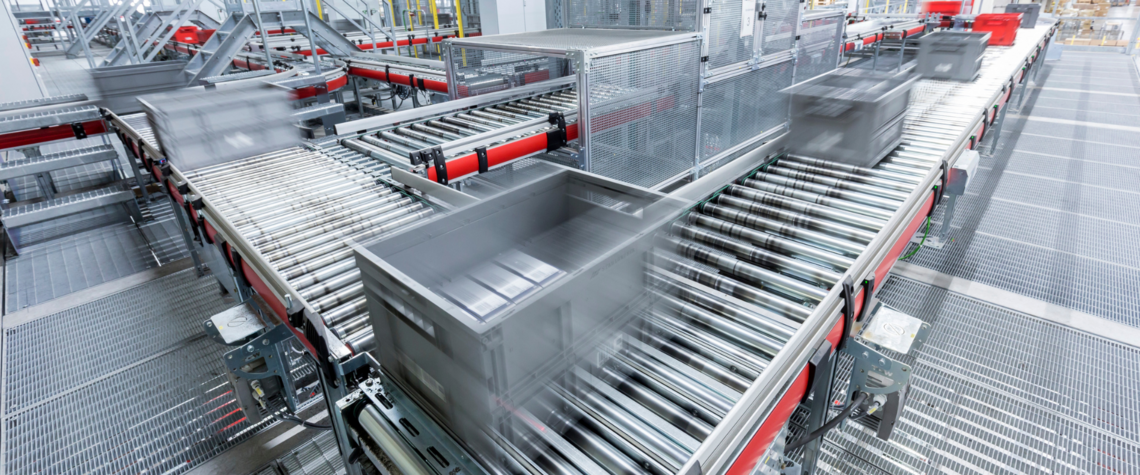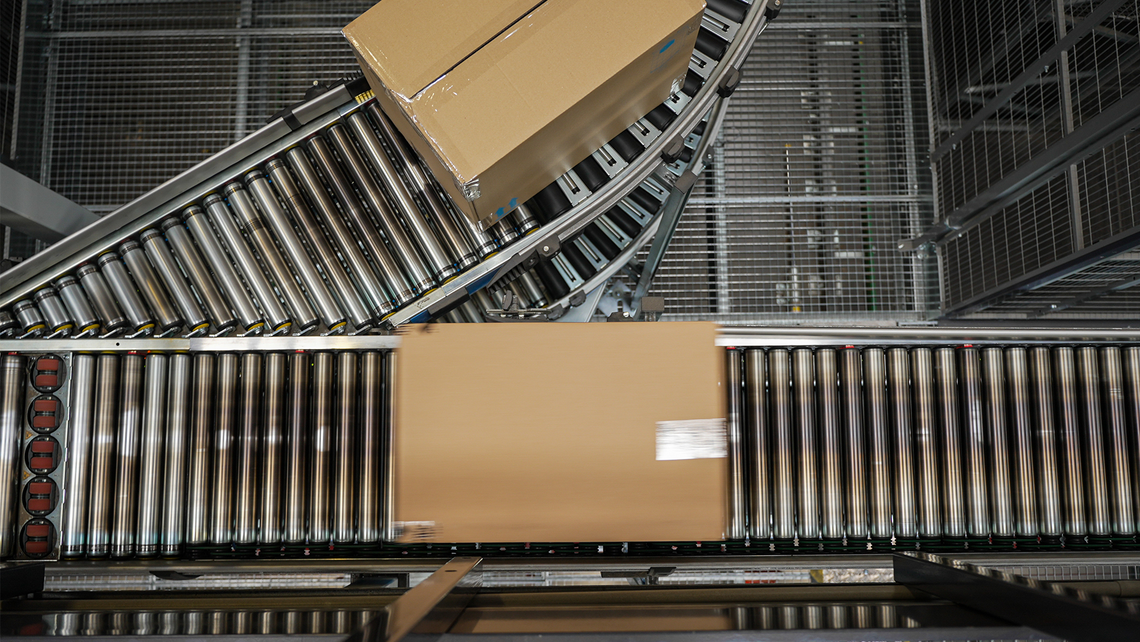![[Translate to North America:] consumer goods logistics automation strategy](/fileadmin/_processed_/8/f/csm_Building_an_Automation_Strategy_Header_0b3eb911fa.png)
![[Translate to North America:] consumer goods logistics automation strategy](/fileadmin/_processed_/8/f/csm_Building_an_Automation_Strategy_Header_0b3eb911fa.png)
Offering an omni channel customer experience is no longer a luxury for retail brands; it’s a necessity. On top of competitive prices, consumers expect a dynamic shopping experience, fast delivery, order tracking, and an easy returns process. Juggling all these deliverables while maintaining a cost-efficient operation requires a reliable warehouse automation strategy built for omni channel success.
Omni channel retail facilitates a unified shopping experience across online and physical touchpoints. It’s an integrated ecosystem that allows customers to engage with a brand and make purchases on their phones, laptops, and in stores.
Pulling this off requires an innovative approach to consumer goods logistics with automation technology and warehouse management software as the backbone. However, simply incorporating these systems doesn’t guarantee success. Companies must create an automation strategy that addresses customers’ needs, operational pain points, industry demands, and long-term goals.
Core Challenges of Omni Channel Logistics
Over the last decade, online shopping has transformed how consumers interact with brands. One-touch mobile transactions, virtual shopping assistants, and AI-driven product recommendations create an immersive and highly personalized experience. These are propelling retail ecommerce sales, which are expected to exceed $4.3 trillion worldwide in 2025.
To stay competitive, retail companies must overcome this new consumer landscape with many supply chain and fulfillment obstacles.
- Fluctuating Order Volume: Fulfillment centers must be able to scale up or pull back during sudden shifts in demand. This has been especially difficult during the past five years due to geopolitical and health crises, causing significant fluctuations in shopping behavior.
- Multiple Sales Channels: Operational silos are hard to avoid when consumers shop via multiple online and in-store channels. Retail companies must maintain a fully integrated consumer goods logistics system that supports a consistent customer experience and cost-effective goods-to-person (GTP) process.
- Inventory Accuracy and SKU Complexity: Omni channel fulfillment centers have a constant flow of products entering and leaving the facility. Add a vast product range, complicated SKU structure, and regular returns to the equation, and inventory control gets tricky. Companies need real-time inventory visibility to prevent stockouts and overstocking.
- Labor Shortages and High Turnover: With labor instability so prevalent today, operational continuity is tough to achieve. Worker shortages and high turnover rates force companies to rely on omni channel warehouse automation for operational consistency.
These challenges are directly tied to the omni channel experience consumers have come to expect from retail brands, and these expectations will continue to evolve.
To meet their customers where they are (which is everywhere), companies need an end-to-end automation strategy that incorporates equipment and software designed specifically for their fulfillment infrastructure.
![[Translate to North America:] consumer goods logistics automation strategy](/fileadmin/_processed_/f/3/csm_Building_an_Automation_Strategy_Inner_1_0dfd1326d7.png)
![[Translate to North America:] consumer goods logistics automation strategy](/fileadmin/_processed_/f/3/csm_Building_an_Automation_Strategy_Inner_1_0dfd1326d7.png)
Key Components of an Omni Channel Automation Strategy
Warehouse automation drives successful consumer goods logistics by creating fully integrated workflows that enable agility and scalability throughout the material handling process. It connects a fulfillment center to every customer touchpoint, creating a holistic ecosystem of machines, software, and human workers.
Each fulfillment center is different, but there are several components that all omni channel retail operations require.
Fast, error-free order picking is the foundation of retail fulfillment automation. A goods-to-person and shuttle system matches the speed at which orders arrive so that companies can meet or exceed delivery expectations.
When a customer places an order, intelligent shuttle robots immediately retrieve the item from the automated storage racks. They transport the goods needed for the order to a conveyor network that carries it to a robotic or manual picking workstation. Once picked, the order moves to the shipping area, and unused items are restocked in the shuttle system.
Any successful omni channel operation requires a Warehouse Management System (WMS) to oversee all automated processes. This includes Warehouse Execution Software (WES), which manages order fulfillment and inventory management.
A WMS syncs online and in-store order flows. It processes orders based on priority and current workflow, then communicates with the goods-to-person system. This helps maintain a smooth workflow and prevent bottlenecks.
TGW Logistics' WERX WMS provides complete control over omni channel fulfillment centers. This powerful software orchestrates every step in the material handling process, supports real-time inventory management, and provides analytics that help improve operational efficiency.
Successful consumer goods logistics must include an easy return process, which is challenging in a multi-channel sales and fulfillment environment.
An automated returns management system uses reverse logistics to ensure each return gets tracked, recorded, and restocked. Scanning technology determines if returned orders are damaged and routes them to the appropriate station for review.
Automation also keeps the customer informed during the returns process by providing real-time status updates and triggering automatic refunds. If a customer returns an online order at a physical store, the system updates the inventory for the fulfillment center where it originated.
Benefits for Retail and Consumer Goods Logistics
We know automation is crucial for meeting the demands of an omni channel retail experience. However, it’s often hard to predict the short- and long-term advantages of implementing end-to-end warehouse automation and software.
Here’s a breakdown of the top benefits for retail and consumer goods logistics operations.
- Faster Fulfillment and Customer Satisfaction: An omni channel automation strategy enables companies to stay ahead by offering same-day delivery. This, along with multi-channel ordering, product tracking, and returns, enhances customer satisfaction and brand reputation.
- Reduced Operational Costs: An omni channel automation strategy eliminates costly inefficiencies in material handling. It helps companies optimize warehouse space, reduce fulfillment errors, and prevent lost inventory.
- Optimal Labor Use: Warehouse automation creates a unified workflow, enabling employees to work efficiently at any stage in the GTP process. Automation reduces the need for manual labor and supports a skilled workforce trained to operate technical systems.
- Scalability: End-to-end automation helps fulfillment centers pivot to handle seasonal peaks, lulls, and planned business growth. When built for omni channel operations, automation ensures the system runs optimally, regardless of order volume.
No two omni channel operations are exactly alike, but they all share one thing in common—they need a tailored strategy. TGW Logistics understands the harsh demands of the consumer marketplace. We work closely with retail companies to find the best solutions for their fulfillment operations and customer needs.
![[Translate to North America:] consumer goods logistics automation strategy](/fileadmin/_processed_/d/4/csm_Building_an_Automation_Strategy_Inner_2_e5e569f79c.png)
![[Translate to North America:] consumer goods logistics automation strategy](/fileadmin/_processed_/d/4/csm_Building_an_Automation_Strategy_Inner_2_e5e569f79c.png)
TGW Logistics Omni Channel Expertise in Action
TGW Logistics brings retail and consumer goods logistics to life with tailored strategies to help companies reach their business goals. Our experts design custom solutions based on each unique environment to make omni channel success possible.
After rapid growth, INTERSPORT, an international sporting goods retailer, needed upgrades to its outdated system and manual order processing operation. We partnered with them and created an innovative consumer goods logistics solution in their Wels, Austria, campus. By implementing our FlashPick GTP solution, we were able to consolidate all logistics processes under one roof, reduce operational costs, and help INTERSPORT create a flexible omni channel environment.
To learn more about TGW Logistics’ approach to omni channel logistics, listen to a recent episode of Omni Talk Retail, with guest Stipe Galic, Vice President of Business Development for TGW Logistics.
You can also dive deeper into supply chain efficiency and advanced warehouse automation solutions in the following blog articles:
Modernize Your Operation
Creating a successful omni channel fulfillment operation requires an automation strategy built specifically for your infrastructure. To do this, you need a partner ready to grow alongside you.
TGW Logistics will tailor a consumer goods logistics plan that incorporates state-of-the-art automation. We make omni channel success possible and won’t stop until we achieve it.
![[Translate to North America:] inbound logistics for returns processing](/fileadmin/_processed_/1/d/csm_Optimizing_Returns_Processing_Header_05f53bbcfd.png)
![[Translate to North America:] goods-to-person order fulfillment](/fileadmin/_processed_/b/b/csm_Goods_to_Person_Blog_Header__f1084d6e53.png)

![[Translate to North America:] Material Handling Solutions Mobile Robotics](/fileadmin/_processed_/1/d/csm_TGW_Tailored_Solutions_header_73f86eca0b.png)
![[Translate to North America:] Warehouse Automation Strategies](/fileadmin/_processed_/e/5/csm_TGW_Building_Future-Proof_Strats_header_76ed3c6d08.png)
![[Translate to North America:] warehouse automation](/fileadmin/_processed_/e/b/csm_TGW_Warehouse_Automation_header_190b49cf82.png)
